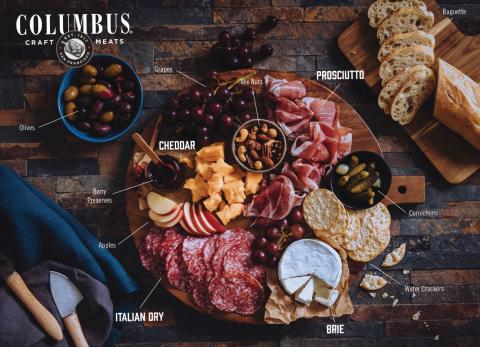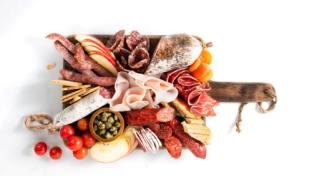What to Expect for Festive Gatherings in Q4

In Charles Dickens’ novel “A Christmas Carol,” Ebenezer Scrooge purchases a huge prize-winning turkey for the prolific and impoverished Cratchit clan. The Cratchits also consume mashed potatoes and boiled pudding. Today, nearly 200 years later, turkey and mashed potatoes are still important fourth-quarter menu items, but this traditional fare is now often accompanied by dishes brandishing new — and more daring — flavor and ingredient combinations.
Heavily spiced foods, sweet/salty combinations, and flavors like ginger and sweet fruits are permeating appetizers, side dishes and desserts. Hot peppers may be paired with chocolate, while cheese is being infused with avocado. Emphasis is on foods like charcuterie, miniature cakes and salads. Items are often placed on serving boards, allowing guests to sample myriad flavors in small amounts. Boards can emphasize brunch, dessert or other meal occasions.
“People are taking familiar things and pairing them with more ‘exploratory’ foods to create ‘wow’ factors,” says Holly LaVallie, VP of marketing at Hormel Foods, in Austin, Minn. “You typically think of cheese and crackers, but people are putting cheese with cornbread and jalapeños, or pairing salami with chocolate or fruit. While the trend is consistent across the board, it’s more prevalent in appetizers. The risk is lower because it’s a smaller portion of the meal. We’re also seeing traditional meats like turkey paired with something more exciting than stuffing.”

Like the Cratchits, Americans are planning sizeable gatherings for the 2022 fourth-quarter holidays as COVID-19 fears subside. In May, IRI’s Primary Shopper Survey found that 35% of consumers are “extremely concerned” about the virus, compared with 59% in March 2020. This is the lowest level to date.
“Come holiday season, there will still be COVID concerns, but not enough to drive huge shifts regarding celebrations,” predicts Paul Baker, founder of Manchester, United Kingdom-based St Pierre Group Ltd. “After three years of get-togethers being impacted, shoppers will be ready to welcome back friends, family and neighbors.”
During lockdown, shoppers improved cooking skills and tested fancy ingredients. Now they want to show off. “Consumers prepared most meals at home these last few years,” notes Kent Harrison, VP, fresh meats marketing and premium programs at Springdale, Ark.-based Tyson Foods. “They became more comfortable and started experimenting with new flavors and premium cuts of meat they may have previously found intimidating.”
Inflation is also driving home entertaining, since home gatherings are far cheaper than dining out for the holidays. The 2022 “Power of Meat” study, conducted by FMI and the North American Meat Institute, found that 61% of consumers are eating out less and ordering takeout less frequently, with 62% trying to recreate restaurant experiences at home. “We expect this to continue during the holidays,” says Harrison.

Charcuterie: A 15th-Century Craze
Charcuterie first gained attention at social gatherings in 15th-century France. In recent years, these cured meats have become very popular in the United States. According to the website Tastewise, charcuterie consumption has been increasing by 16.11% annually. In addition to this rise in popularity, charcuterie boards are becoming increasingly creative.
“The trend keeps growing, with charcuterie becoming commonplace,” observes Heather Prach, education director at the Madison, Wis.-based International Dairy Deli & Bakery Association (IDDBA). “We now have brunch and dessert boards. People can artfully arrange boards and accommodate all guests, even if they’re vegan or gluten-free.”
Boards’ contents often go beyond meat as a focus. One recipe site discussed a mango charcuterie board featuring red wine vinegar, brown sugar, chile de arbol, turmeric and mustard. “People aren’t afraid to mix salty and sweet,” says Prach. “You can mix things and not be conventional.”
Some charcuterie meats have become fancier. Charcuterie leader Hormel is focusing on wine-infused artisanal salamis. Its point-of-sale materials and cross-merchandising end caps tell a comprehensive charcuterie board serving story, as do its social media initiatives. Using a chart-like grid, Hormel offers pairings involving cheese, peppers, jelly, wines and other items.
“People are creating a total experience,” says LaVallie. “We provide whole solutions.” Cost World Plus, she adds, does a particularly good job of cross-merchandising Hormel’s charcuterie with pairing suggestions.
Some boards even include fish. Genova Premium Seafood uses social media to discuss “grazing board” serving suggestions for its premium tuna brand, according to Lara Berman, senior brand manager at El Segundo, Calif.-based parent company Chicken of the Sea. Recently, Genova partnered with “Top Chef” judge and cookbook author Gail Simmons to develop a Tuna Romesco Salad Board inspired by the Spanish condiment. Genova also ran a contest in which 75 fans won a curated dinner party collection.
Genova’s Facebook page also features recipes for Pistachio Pesto Pasta with asparagus, and Tuna Linguine Arrabbiata. Arrabbiata is a spicy Italian sauce made from garlic, tomatoes and chili peppers.
“Preferences for heavily spiced foods have steadily increased over the past decade,” adds Berman. “Tuna is the perfect protein to eat as-is or spiced to taste. Consumers ages 19 to 44 are more likely than older counterparts to try international cuisines. This is an indicator for future international cuisine growth.”
Social media has driven interest in international cuisine. TikTok introduced people to quesabirria, a quesadilla filled with birria meat, notes Tyson’s Harrison. Birria, a beef stew from Jalisco, Mexico, exemplifies the growing popularity of regional cuisines.
Social media trends can travel quickly. “What started with a TikTok influencer is being talked about by national news outlets,” observes Berman. “Something on Twitter is suddenly picked up by Bon Appetit.”

Bread: The Staff of Life
No feast would be complete without bread. Even in this staple category, however, consumers want pizazz. Of French origin, brioche offers a high egg and butter content and a rich, tender texture to satisfy that need. As a result, the U.S. market for brioche has more than tripled over the past four years.
“Brioche is an easy way to upgrade occasion dinner rolls, French toast and sharing platters,” affirms St Pierre’s Baker. “Brioche is up 14% year on year according to Nielsen [May 21, 2022]. Brioche is incredibly versatile. It can be used for multiple occasions to elevate a regular meal without alienating any guests. Brioche’s delicate sweetness has wide appeal.”
In bakery departments, St Pierre draws attention to its ready-baked breads with rustic baskets and Eiffel Tower displays. This fall, the company will launch a frozen bake-at-home line that consumers can simply defrost and pop in the oven. “We’re offering fresh-baked bread without hard work,” says Baker. Offerings will include a 2-pack of French baguettes, a single baguette and a 4-count of French dinner rolls.
Meat Takes Center Stage
Fresh meat — including roasts, steaks and loins — continues to be the main course for many holiday gatherings. According to Michael Uetz, principal at Chicago-based Midan Marketing, which represents the meat industry, beef and pork remain “very traditional” parts of family gatherings.
High restaurant prices, coupled with consumers’ augmented kitchen skills, are encouraging people to purchase more premium cuts for home entertaining, says Jim Rogers, SVP of sales at Creekstone Farms, in Arkansas City, Kan. For the many shoppers who want unadulterated foods, Creekstone’s Natural Black Angus beef and Natural Duroc Pork contain no antibiotics or added hormones. “Retailers can showcase premium products while meeting customers’ health-and-wellness needs,” notes Rogers.
Saving money is still important, however. Uetz points to the 2008 recession, when shoppers purchased more chuck roasts. While chuck is pricey, families can make several meals from one roast. The current moment “is an opportunity for retailers and suppliers to help consumers envision how alternative cuts still bring holiday cheer,” he adds. Online and in stores, Uetz cites the importance of cross-merchandising meat with other foods: “Shoppers are shopping for meals, not meat.”
For Thanksgiving and other holidays, turkey is still a popular option. More people are cooking the birds in different ways, though, including smoking, brining and frying. There’s also a Hispanic influence involving chipotle turkey and spicy recipes, as well as turkey prepared with hot honey. “There’s more foodies, with people doing something unique or fun,” says Joseph DeCicco Jr., partner/head of purchasing at Pelham, N.Y.-based specialty grocer DeCicco & Sons.

Catering Versus Home Cooking
For the fourth quarter, many shoppers plan to serve homemade foods alongside ones that are catered or from deli departments. They can save money on one end and time on the other. “Turkey pre-orders have been huge in recent years,” notes DeCicco. “While home cooking is still big, convenience is huge. Many catered orders are combined with something fun made at home.”
In response to this trend, DeCicco’s has upgraded online menus and ordering technologies. “We’re making our restaurant software more integrated and customizable,” says DeCicco. “Shoppers can pre-pay or pay at pickup.” This year, the grocer is also upgrading online ordering for customized cakes.
At SpartanNash, in Grand Rapids, Mich., CMO Amy McClellan cites strength in prepared salads, meals and other deli items. “As shoppers host more holiday gatherings, many are opting for simplicity and convenience so they can spend more time reconnecting rather than prepping in the kitchen,” says McClellan.
“Trays” and combo meals have experienced significant growth, notes Baker, adding that pre-packaged party platters offering variety are also trending: “Deli prepared is having a real ‘moment,’ which will play a key role in holiday shopping.” Hosts can personalize platters by buying individual products to create their own unique spreads, and bread is a must at these occasions. St Pierre’s products work with both savory and sweet items. The brand’s offerings include brioche burger buns and hot dog rolls, sliced brioche loafs, brioche sliders, and brioche baguettes.
Despite optimism regarding fourth-quarter purchasing, rising prices continue to raise concerns. Experts are unsure whether inflation will affect holiday entertaining. “It’s hard to predict,” admits IDDBA’s Prach. “While people want smaller amounts, we’re still seeing decadent buying trends. It’s hard to deduct from last year, because there was a COVID scare around the holidays.”
Regardless of how big or small holiday gatherings are and what is served, one tradition will persevere: There will always be hot cocoa and a plate of cookies for Santa.
Alcoholic beverages have always been part of holiday gatherings. This year is no exception, with experts citing interest in local and seasonal beers, special-occasion wines, and ready-to-drink cocktails.
Grand Rapids, Mich.-based SpartanNash offers a variety of wines at multiple price points. CMO Amy McClellan notes consumer interest in wines from “under-the-radar” countries and local regions. During the fourth quarter, however, consumers usually embrace more “serious,” higher-priced wines, including sparkling ones and deeper, darker reds.
Many of SpartanNash’s stores have dedicated wine stewards “who are incredibly knowledgeable about our wide selection,” adds McClellan. “They’re great at identifying similar taste profiles at any price range.” The company also emphasizes beer, with fall bringing popular seasonal flavors like apple, pumpkin and Oktoberfest varieties, she observes.
Customers of Pelham, N.Y.-based specialty grocer DeCicco & Sons are interested in regional microbrews, including pilsners, lagers, and seasonal flavors like pumpkin. IPAs with lower alcohol content are also gaining ground. “People want flavor and drinkability, but don’t want to feel too full when pairing beer with food,” says Joseph DeCicco Jr., partner/head of purchasing. DeCicco also cites strength in hard seltzers, which are growing faster than beer.
The pandemic heightened interest in homemade cocktails, augmenting DeCicco’s business in high-end bitters, tonics, ginger beer and other ingredients. “There’s a correlation between home chefs and homemade cocktails,” notes DeCicco.
Consumers’ desire for quality ingredients has raised the bar in ready-to-drink (RTD) cocktails. Unlike the artificially flavored RTDs of years past, today’s products are made with better-quality spirits and natural mixers. Launched last year, Brody’s Crafted Cocktails contain ingredients like fresh juice, fresh ginger, botanicals and honey, “as opposed to anything artificial,” says John Neunson, co-founder of Collingswood, N.J.-based Brody’s.
The brand’s five prohibition-era cocktails feature an updated, trendy twist. Touch of Grey, for example, contains London-style premium dry gin, Earl Grey tea, black raspberry, honey and lemon, while Black Orchid includes premium vodka, violet liquor, black raspberry and very tart lemon flavors. Packaged in 375-milliliter glass bottles (12-plus ounces), the cocktails are meant for sharing, yielding three to five servings. The ABV is 16% to 25%, and suggested retail prices range from $12.90 to $14.99.
“Our attention to detail brings a true experience to home entertaining,” asserts Neunson, “and you don’t have to act as bartender.” Later this summer, the brand plans to add three additional cocktails to the lineup.





